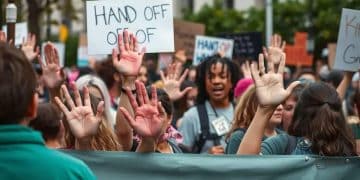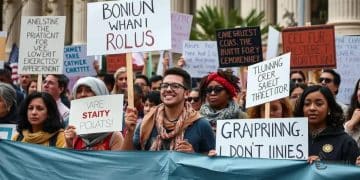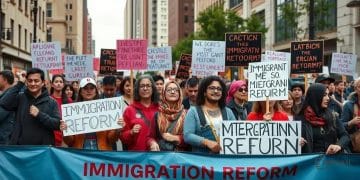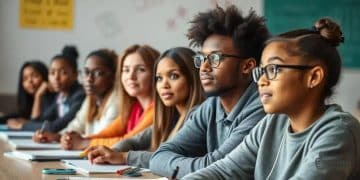Movements promoting civil and human rights: a global perspective
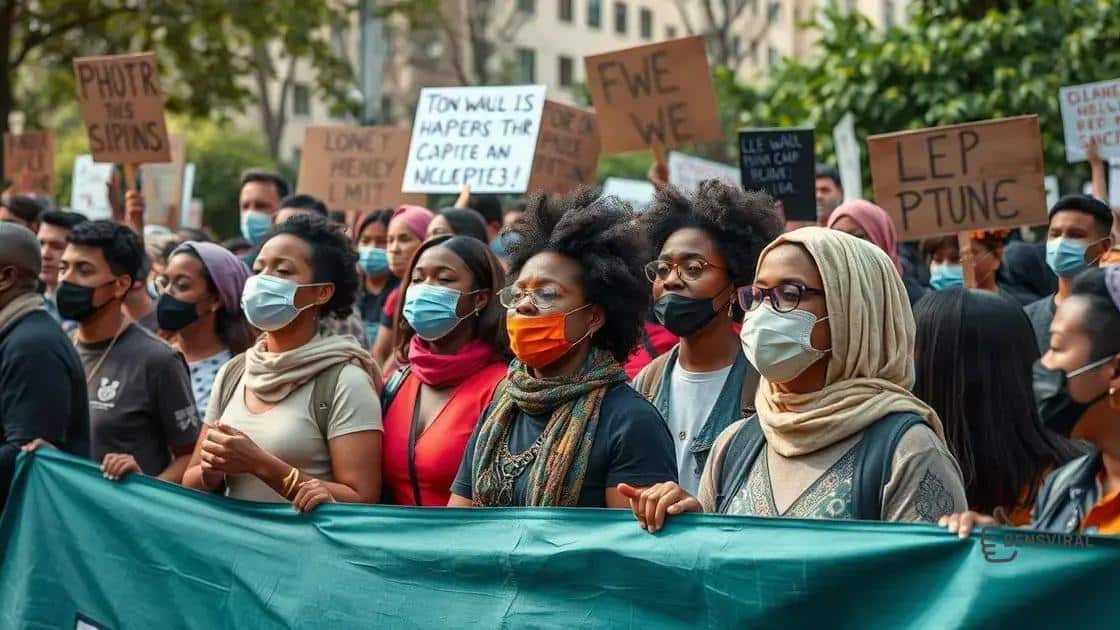
Modern civil rights advocates face challenges such as political polarization, misinformation, funding shortages, and institutional resistance, which hinder their efforts to promote equality and justice.
Movements promoting civil and human rights have shaped societies worldwide, driving change through collective action. Have you ever wondered how these movements evolve and impact our daily lives? Let’s explore their significance.
Understanding the history of civil rights movements
Understanding the history of civil rights movements is crucial for recognizing how far we have come as a society. These movements have played a significant role in shaping our understanding of equality and justice.
Throughout history, various groups have emerged to fight for their rights. One of the earliest movements was the abolitionist movement, which aimed to end slavery in the United States. This movement laid the groundwork for future civil rights activism.
The Civil Rights Movement of the 1960s
The Civil Rights Movement of the 1960s was a pivotal moment in history. It sought to end racial segregation and discrimination against African Americans. Leaders like Martin Luther King Jr. and Rosa Parks became symbols of hope and activism.
- Peaceful protests and marches were common strategies.
- The landmark Civil Rights Act of 1964 prohibited discrimination based on race.
- Grassroots organizations played a vital role in mobilizing communities.
Another significant event was the Stonewall Riots in 1969, which marked the beginning of the modern LGBTQ+ rights movement. This uprising highlighted the injustices faced by the LGBTQ+ community and sparked a nationwide push for equality.
Global Perspectives on Civil Rights Movements
While the focus is often on the United States, civil rights movements have occurred around the world. For instance, in South Africa, the struggle against apartheid led by figures like Nelson Mandela brought international attention to issues of racial injustice.
These movements share common goals, such as the fight for social justice, equality, and recognition of human rights. In each case, ordinary people have come together to demand change, showing the power of collective action.
- Various global movements include the anti-apartheid struggle and women’s suffrage.
- International solidarity has been essential in advancing these causes.
Understanding these histories helps us appreciate the sacrifices made by countless individuals who fought for the rights we enjoy today. Their legacy reminds us that the fight for civil and human rights is ongoing and still relevant in our current society.
Key figures in human rights advocacy
Key figures in human rights advocacy have made lasting impacts on our society. Their dedication and courage have inspired movements around the world. From local heroes to international icons, these individuals have shaped the way we view justice and equality.
One such figure is Malala Yousafzai, who advocates for girls’ education. After surviving a violent attack for speaking out, her message only grew stronger. Malala’s work has brought global attention to education rights, showing how one person can influence millions.
Influential Leaders in the Fight for Justice
Another essential figure is Nelson Mandela, who fought against apartheid in South Africa. His leadership and resilience during 27 years in prison highlighted the fight against racial injustice. Mandela’s commitment to peace and reconciliation has made him a symbol of hope worldwide.
- Worked toward ending systemic racism.
- Promoted forgiveness over revenge.
- Received a Nobel Peace Prize for his efforts.
Rosa Parks is also a pivotal figure in the American Civil Rights Movement. By refusing to give up her seat on a bus, she sparked a nationwide boycott. Parks’ actions are a powerful reminder of how a single act of bravery can ignite change.
Modern Advocates Shaping Our Future
In contemporary times, figures like Greta Thunberg have become prominent advocates for climate justice. Through her activism, she highlights the connections between human rights and environmental issues. Greta’s determination has mobilized young people and brought climate discussions to the forefront of human rights agendas.
The common thread among these advocates is their deep belief in equality and fairness. Each has contributed uniquely to the struggle for human rights, reminding us that every voice can make a difference. Whether they speak for education, racial equality, or environmental justice, their legacies inspire ongoing action.
The role of grassroots organizations
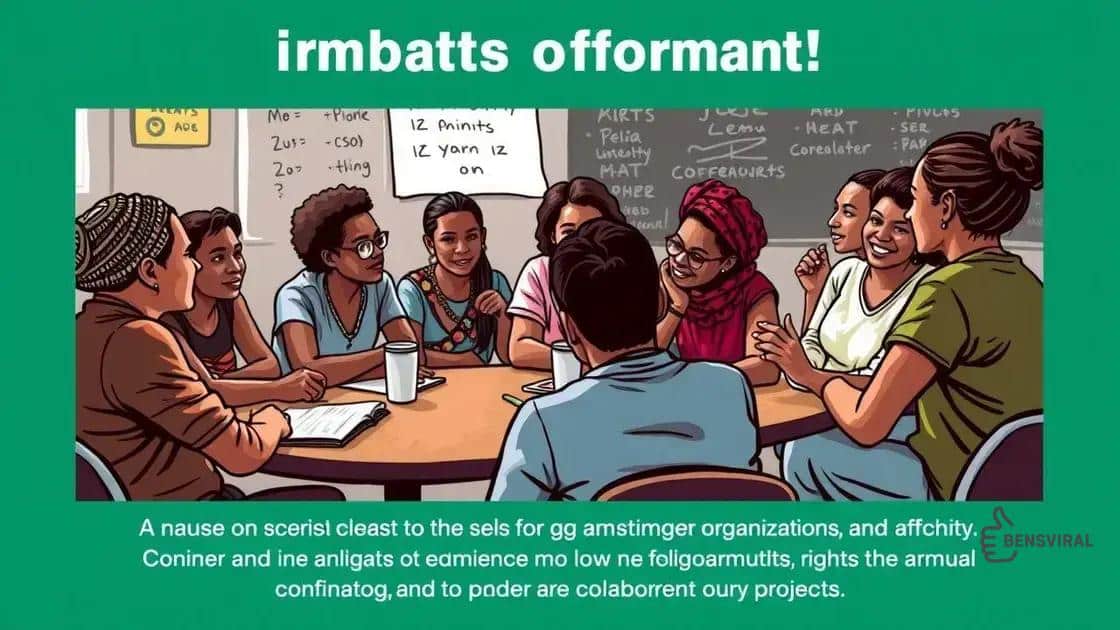
The role of grassroots organizations in civil and human rights movements cannot be overstated. These groups often emerge from the communities they serve, empowering individuals to advocate for their own rights and needs. Grassroots organizations connect people and drive local action, making them vital in the fight for justice.
One major aspect of their impact is community mobilization. These organizations build networks that encourage people to participate actively in advocacy efforts. They educate individuals about their rights and provide platforms for their voices to be heard.
Examples of Successful Grassroots Movements
Various successful grassroots movements illustrate the importance of local organizations. The Black Lives Matter movement started as a grassroots campaign against police brutality and systemic racism. It has grown into a worldwide organization that champions racial equality.
- Grassroots efforts reach diverse communities.
- Provide essential support and resources.
- Engage in local and national advocacy.
Another example is the Women’s March, which began in response to political events in the United States. This grassroots organization has brought together millions of people, creating visibility for issues such as reproductive rights, gender equality, and social justice.
Challenges Faced by Grassroots Organizations
Despite their crucial role, grassroots organizations face challenges. Often, they operate with limited funding and resources. This can make it difficult to maintain sustainability and effectiveness in their advocacy efforts. Additionally, grassroots activists sometimes encounter pushback from political and corporate entities, which can hinder progress.
Yet, the resilience of these organizations is inspiring. They adapt and continue to work toward their goals, proving that community-driven change can occur even in the face of adversity. By focusing on local needs and fostering connections, grassroots organizations create powerful movements that challenge injustices and push for equality.
How social media amplifies movements
Social media plays a vital role in amplifying movements focused on civil and human rights. It provides a platform for voices that might otherwise go unheard. With just a smartphone, anyone can share their story and connect with a global audience.
One major impact of social media is its ability to spread information quickly. For example, hashtags like #BlackLivesMatter allow people to easily find and share related content. This creates a sense of community and solidarity among activists worldwide.
The Power of Viral Content
When a post resonates, it can go viral, reaching millions of people within hours. This rapid spread of information allows critical issues to gain public attention. People can learn about injustices, events, and protests in real-time, making them more aware and engaged.
- Social media helps organize protests and rallies.
- It promotes educational initiatives and campaigns.
- Users can share personal experiences, fostering empathy.
Moreover, social media platforms enable individuals to interact directly with organizations and leaders. This opens up lines of communication that were not possible in the past. Activists can ask questions, share concerns, and demand answers, amplifying their collective voice.
Challenges and Risks of Social Media Activism
However, social media is not without challenges. Misinformation can spread just as quickly as important messages, leading to confusion. Additionally, activists often face online harassment and censorship, which can discourage participation.
Despite these issues, the benefits of using social media to amplify movements outweigh the drawbacks. It empowers marginalized voices and fosters global connections. By sharing stories and mobilizing support, social media continues to be a powerful tool for change in the realm of civil and human rights.
Challenges faced by modern civil rights advocates
Modern civil rights advocates face numerous challenges in their ongoing fight for justice and equality. These obstacles can hinder their progress, even as they strive to create a more inclusive society. Understanding these challenges is key to supporting their efforts.
One major challenge is the increasing political polarization. In many regions, civil rights issues have become highly politicized, leading to divisions within communities. This polarization can make it harder for advocates to gain widespread support for their causes.
The Impact of Technology on Activism
Another significant issue is navigating the complex world of social media and misinformation. While social media has empowered activists to reach more people, it has also created a breeding ground for false information. Misinformation can undermine the credibility of movements and create confusion among the public.
- Activists often have to fact-check and correct misconceptions.
- This consumes valuable time and resources needed for advocacy.
- Online harassment and threats are also common, causing fear among advocates.
Funding is a crucial challenge as well. Many civil rights organizations operate on limited budgets. Finding consistent funding can be difficult, which restricts their ability to conduct programs, outreach, and essential activities. This financial strain sometimes limits their capacity to address urgent needs in communities.
Resistance to Change
Moreover, advocates often encounter resistance from institutions that favor the status quo. Whether it’s a reluctance to change policies or push back from law enforcement, this resistance can slow down progress. Advocates must work tirelessly to create dialogue and build trust with these institutions, which can be daunting.
Despite these challenges, modern civil rights advocates continue their vital work. Their resilience and determination shine through as they fight for equality and justice in a complex and often challenging environment. With support and understanding, they can overcome these obstacles and work toward a better future for all.
FAQ – Challenges Faced by Modern Civil Rights Advocates
What are some common challenges civil rights advocates face today?
Civil rights advocates commonly face political polarization, misinformation, funding shortages, and institutional resistance.
How does misinformation impact civil rights movements?
Misinformation can spread confusion, undermine the credibility of movements, and distract from important issues.
Why is funding important for civil rights organizations?
Funding is crucial as it allows organizations to conduct outreach, run programs, and address urgent community needs.
What role does social media play in activism today?
Social media enhances activism by allowing advocates to share information rapidly, organize events, and connect with broader audiences.

